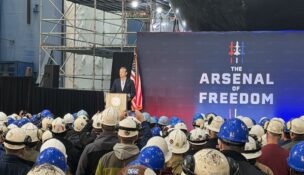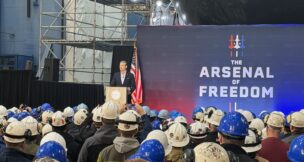Space race
NASA moon-Mars missions are boon for Virginia contractors
Kate Andrews //May 31, 2021//
With NASA on the verge of returning astronauts to the moon and one day to Mars, Virginia’s federal contractors also are taking a giant leap into space, fulfilling millions of dollars in NASA-related contracts over the next decade and possibly beyond.
In a 2020 economic impact study commissioned by NASA, Virginia was ranked sixth in the nation for spending by the aeronautics and space agency, which was responsible for generating 27,000 jobs in the commonwealth (including 2,623 workers directly employed by NASA) in 2019, as well as $2 billion in labor income and $5.5 billion in economic output, including $219.9 million in state and local tax revenue.
In 2019, NASA was responsible for hundreds of millions in sales in several Virginia industries: $489.3 million in truck transportation, $475.8 million in electronic and precision equipment repair and maintenance, and $461.3 million in scientific research and development services, mostly from the agency’s procurement budget. NASA’s Virginia presence includes Hampton’s Langley Research Center, where the Project Mercury astronauts trained, and the Wallops Flight Facility, a rocket launch site in Accomack County.
Recent headlines have focused on NASA’s Artemis program, the mission to the send astronauts back to moon and, ultimately, land the first humans on Mars. Artemis is set to send its first unmanned rocket up in early November, with plans for a new generation of astronauts, including the first woman, to land on the moon in 2024. (A Government Accountability Office report released on May 26 expressed skepticism that NASA can meet the 2024 goal, noting remaining “technical risks” and the fact that the program’s original landing goal of 2028 had been accelerated by the Trump administration in 2019.)
The November unmanned spacecraft mission will be launched with a set of rocket boosters produced by Falls Church-based Northrop Grumman. It’s part of a potential $49.5 million contract through which the Fortune 500 aerospace and defense contractor will produce twin boosters for the next three Artemis missions and three other Space Launch System flights by 2030.
Northrop Grumman also is producing the living space for astronauts during their lunar exploration missions. Known as the Habitation and Logistics Outpost — or HALO — the module is based on Northrop’s Cygnus spacecraft, which is used to deliver supplies and equipment to the International Space Station. Awarded in June 2020, the $187 million HALO contract calls for the module’s launch with a power and propulsion element by the end of 2023.
“This contract award is another significant milestone in our plan to build robust and sustainable lunar operations,” NASA Administrator Jim Bridenstine said in a statement last year. “The [Lunar] Gateway is a key component of NASA’s long-term Artemis architecture, and the HALO capability furthers our plans for human exploration at the moon in preparation for future human missions to Mars.”

Rising competition
Another major player is Reston-based Science Applications International Corp. (SAIC), which is involved with several aspects of the Artemis program, including the launching system, lunar gateway, the Orion crew vehicle and the Human Landing System. The Fortune 500 contractor also has a hand in Commercial Crew Program flights to and from the International Space Station. And it provided validation and verification software services for the Mars Perseverance rover, which landed on the red planet in February. SAIC also will provide support for the eventual manned mission to Mars, ensuring that mission systems software performs correctly.
David Ray, who earlier this year became senior vice president of SAIC’s Space Business Unit, says the space contracting world is becoming more competitive.
In coming years, he suggests, tech and engineering companies of all sizes will enter the industry as the costs of space exploration and travel continue to come down. As technology evolves, he says, the satellites, sensors and payloads used on space missions are becoming smaller and less expensive, while maintaining effectiveness.
“It used to be that the cost of doing business in space was a high barrier to entry, but the lower costs create an opportunity,” he says. “It will open things up for new commercial players, with different avenues. It’s an opportunity for companies to say, ‘How do we take what we do well today, and the partnerships that are available to us now, and how can we add more value to customers in areas that weren’t in play for us a few years back?’ It’s a very exciting time.”
This shift in the space industry is already happening. Commercial firms such as SpaceX and Blue Origin — owned respectively by Elon Musk and Jeff Bezos, the world’s richest men — are pushing the boundaries of space travel, including plans from both companies to offer space tourism flights for deep-pocketed civilians as soon as this summer.
More crucially, however, these space startups also are now competing head to head with traditional, Fortune 500 defense and aerospace contractors.
Bumpy landings?
In April, NASA awarded Musk’s California-based SpaceX the contract for Artemis’ Human Landing System (HLS) that will carry the next two American astronauts to the lunar surface. SpaceX, which bid $2.89 billion, beat out Bezos’ Washington-based Blue Origin and Reston-based Fortune 500 defense contractor Leidos Holdings Inc.’s Dynetics subsidiary in Huntsville, Alabama. Each of the companies was a finalist for the contract, with each producing its own design for the lunar lander.
Blue Origin, which bid $5.99 billion, and Leidos filed formal protests with the General Accountability Office over the award. Although Leidos did not disclose its bid amount, NASA’s statement said that Dynetics’ price tag was “significantly higher” than the other finalists’ bids.
“Dynetics firmly believes our HLS design offers great potential to contribute toward NASA’s HLS program goals, and we believe NASA’s initial plan for continued competition remains the best approach to ensure program success,” the company said in a statement. “Dynetics has issues and concerns with several aspects of the acquisition
process as well as elements of NASA’s technical evaluation and filed a protest with the GAO to address them. We respect this process and look forward to a fair and informed resolution of the matter.” The GAO is required to decide on the protested contract by Aug. 4.
Dynetics isn’t out of the picture, though. In the statement awarding SpaceX the contract, NASA’s Kathy Lueders said, “With time now to address the technical concerns as development continues, Dynetics could be positioned for future missions to the moon, either with NASA under Artemis or with commercial customers.”
Leidos, both under its current name and earlier iterations, has contracted for NASA for decades and is still at work on a 10-year, $2.9 billion contract providing tech support for 10 NASA centers across the country. The NEST (NASA End-user Services and Technologies) contract expires in May 2029. Leidos deemed it “a marquee win” in a statement when the company was awarded the contract in 2019.
As the mission dates get closer for the Artemis program, Virginia companies are likely to get more shots at NASA contracts.
In March, Democratic U.S. Rep. Don Beyer, who represents Virginia’s 8th District and is the new chairman of the House Subcommittee on Space and Aeronautics, said the successful test of NASA’s Space Launch System “brings us one critical step closer to returning to the moon and, someday, landing humans on Mars. After years of development, it’s gratifying to see important and encouraging progress in this key system, which we hope will eventually open opportunities for other scientific missions, in addition to NASA’s moon-Mars program.” ν
Freelance writer Mike Holtzclaw contributed to this story.
i















